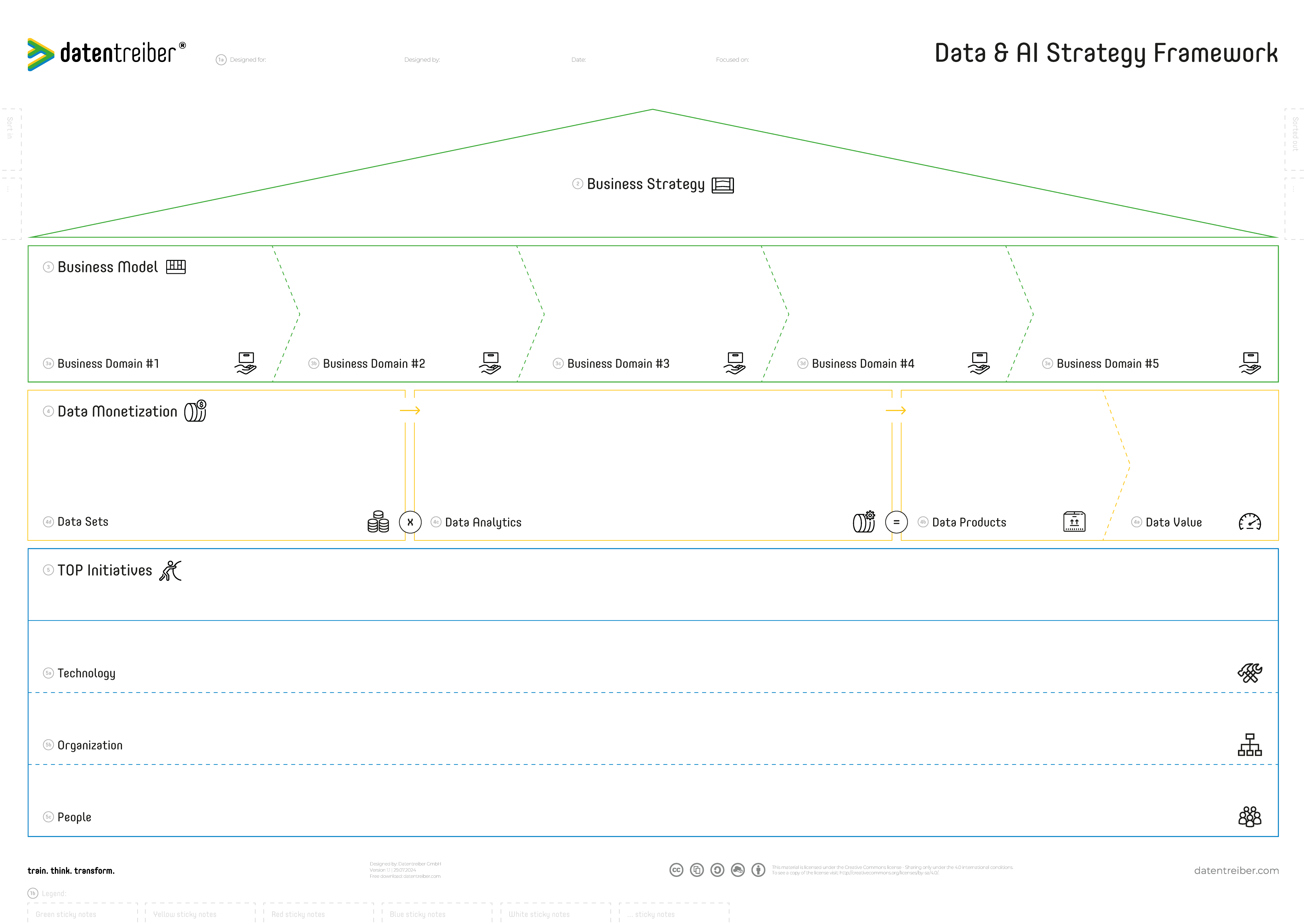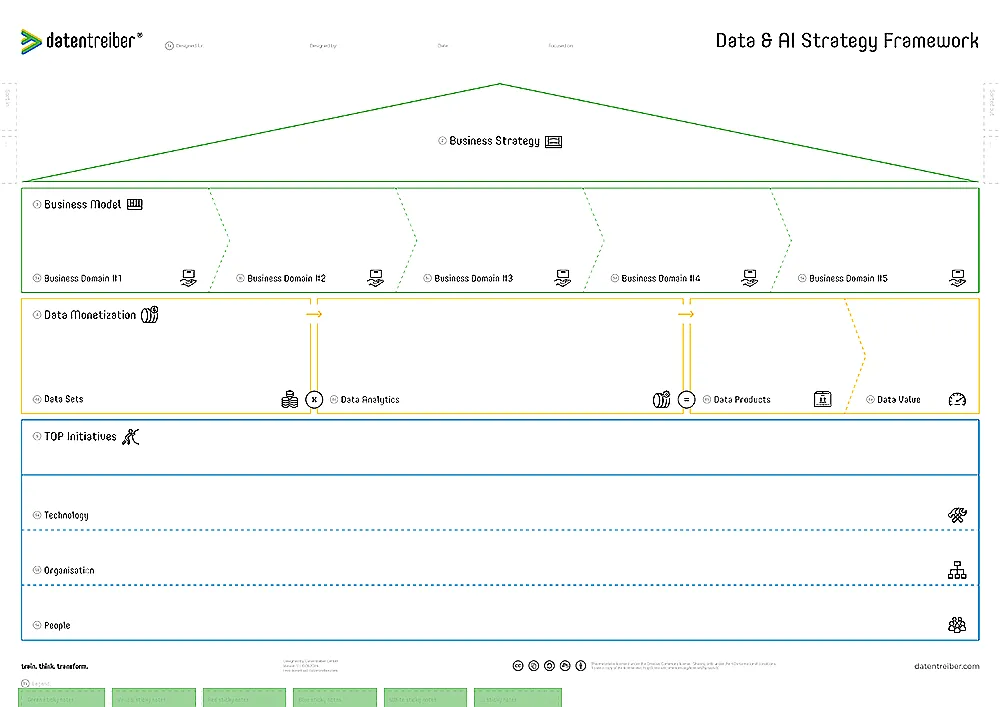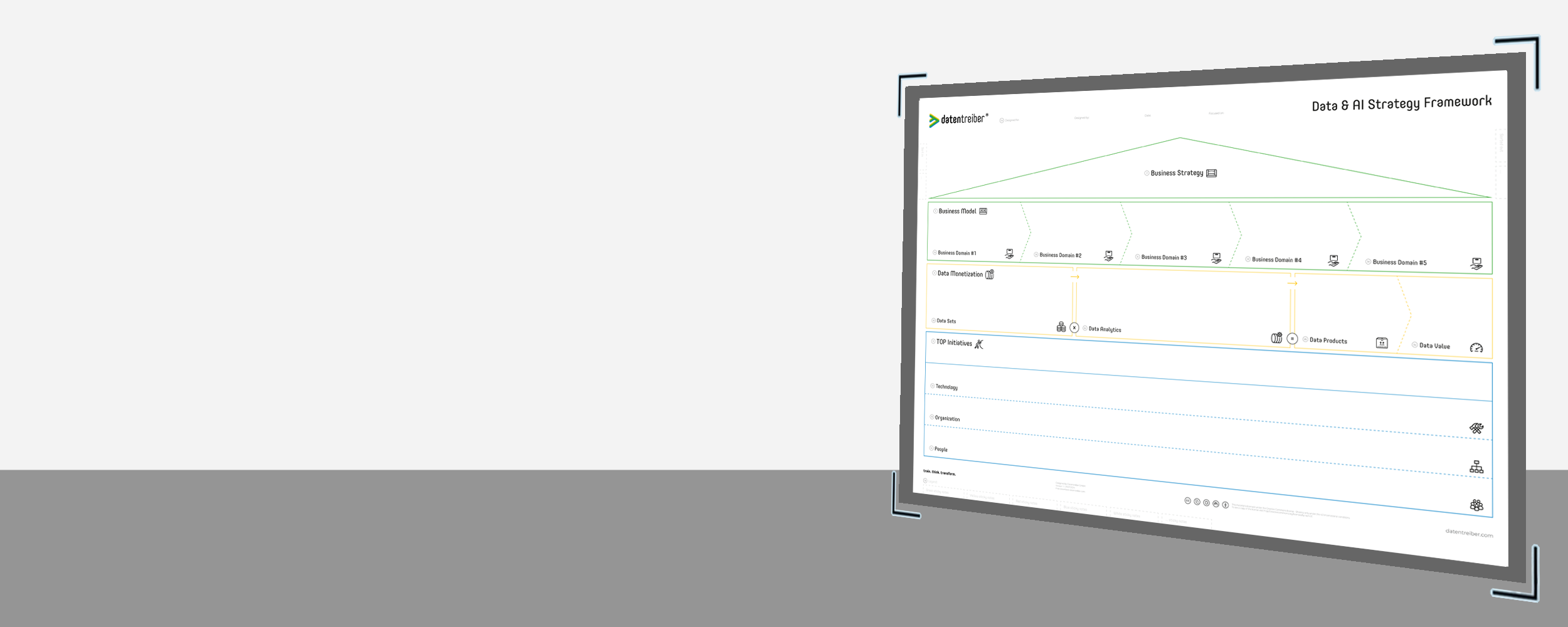
From Business Strategy to Data & AI Products
The Data & AI Strategy Framework Canvas
Visualize and manage your data and AI strategy workshops with the Data & AI Strategy Framework. This tool guides you from strategic vision to practical implementation, integrating key outcomes into one cohesive roadmap.
What is the Data & AI Strategy Framework Canvas?
The Data & AI Strategy Framework Canvas serves as a unifying backdrop for planning, conducting, and concluding a data and AI strategy workshop. It presents a high-level snapshot of key objectives, existing materials, and anticipated deliverables before the workshop begins, and provides a structured reference point for reviewing outcomes and progress once the workshop concludes.
At the start, the canvas helps clarify expectations by recording the workshop’s main objectives and the specific results (deliverables) you aim to produce. It captures relevant preparatory materials and identifies stakeholders, ensuring that everyone enters the workshop with a shared understanding of its purpose and scope. After the workshop ends, the same canvas becomes a reference for finalizing the scope of the data and AI strategy, defining the tangible deliverables, and tracking their completion.
This framework also reflects the top-down and bottom-up dynamics of strategy development and implementation. At the beginning of the workshop, it begins with defining overarching objectives, value requirements, and the envisioned data and AI products, followed by identifying necessary organizational and technological elements. This process is worked on top-down, starting with the strategy and ends with the technological, organizational and personnel requirements.
Once the strategy is established, the canvas supports the subsequent bottom-up implementation process, guiding how resources, organizational structures, and technical capabilities are arranged and deployed to achieve the defined objectives. By providing a coherent framework for aligning initial objectives with eventual outcomes, it helps maintain focus, encourages accountability, and ensures that each step in your data and AI strategy journey is visible and connected.
The Data & AI Strategy Framework Canvas is available for free under a Creative Commons license: You may use and modify the canvas as long as you cite Datentreiber in particular as the source.
When to Use the Data & AI Strategy Framework Canvas?
- Before the Workshop:
Document the workshop’s objectives, intended deliverables, and available preparation materials. Clearly define who will be involved and what is expected, setting a solid foundation for upcoming discussions. - After the Workshop:
Review the completed deliverables, update the canvas to reflect final outputs, and confirm that all objectives have been addressed. This makes it easy to gauge progress, highlight achievements, and determine any remaining steps toward implementing the data and AI strategy.
By using the Data & AI Strategy Framework Canvas at these key points, you ensure continuity and coherence across the entire strategy development process.
How Do I Use the Data & AI Strategy Framework Canvas?
The Data & AI Strategy Framework helps design a business strategy that is:
- Value-oriented: Why does our business use data and AI?
- User-centric: Who in our business uses data and AI?
- AI-empowered: How do we use analytics and AI?
- Data-driven: What data do we use?
The framework ensures that the data and AI strategy is aligned with and integrated into the business strategy, transforming the business model holistically and systematically.
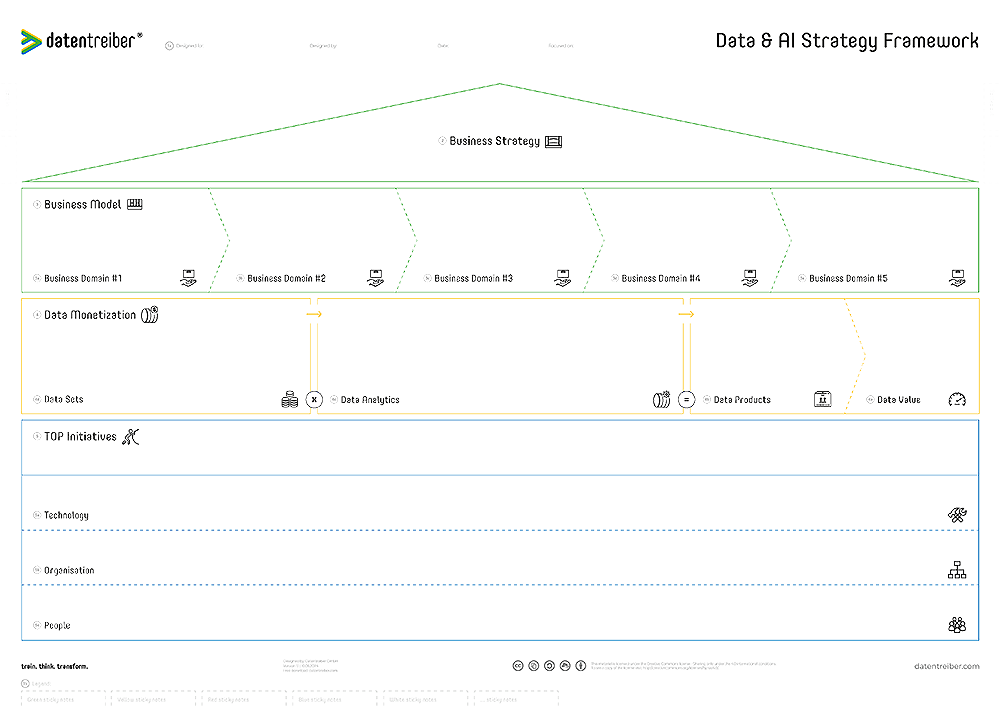
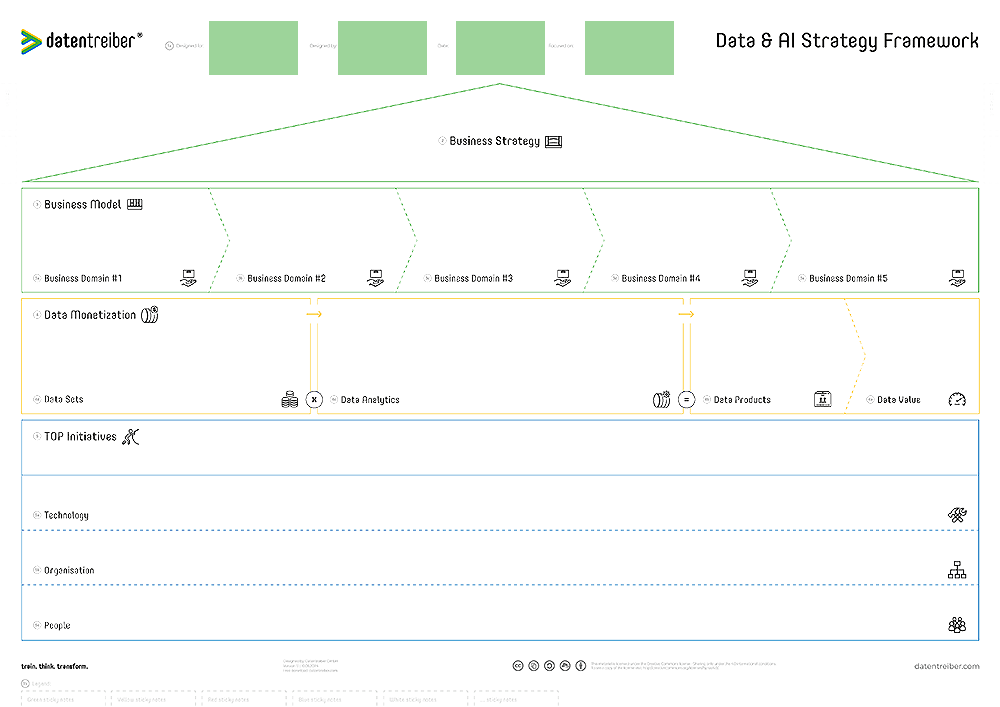
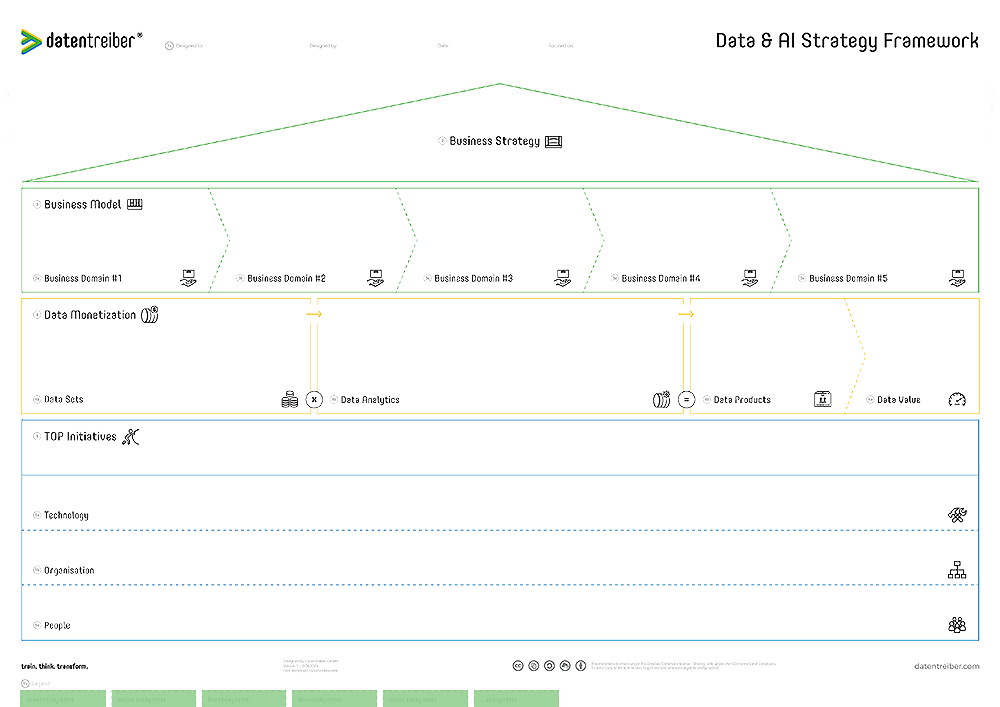
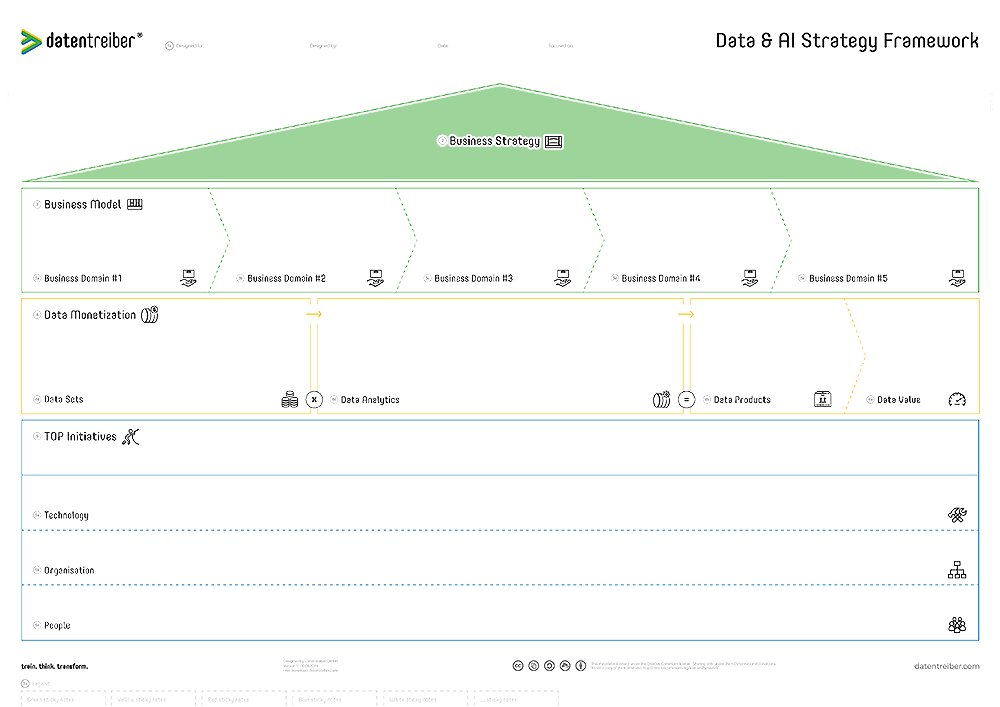
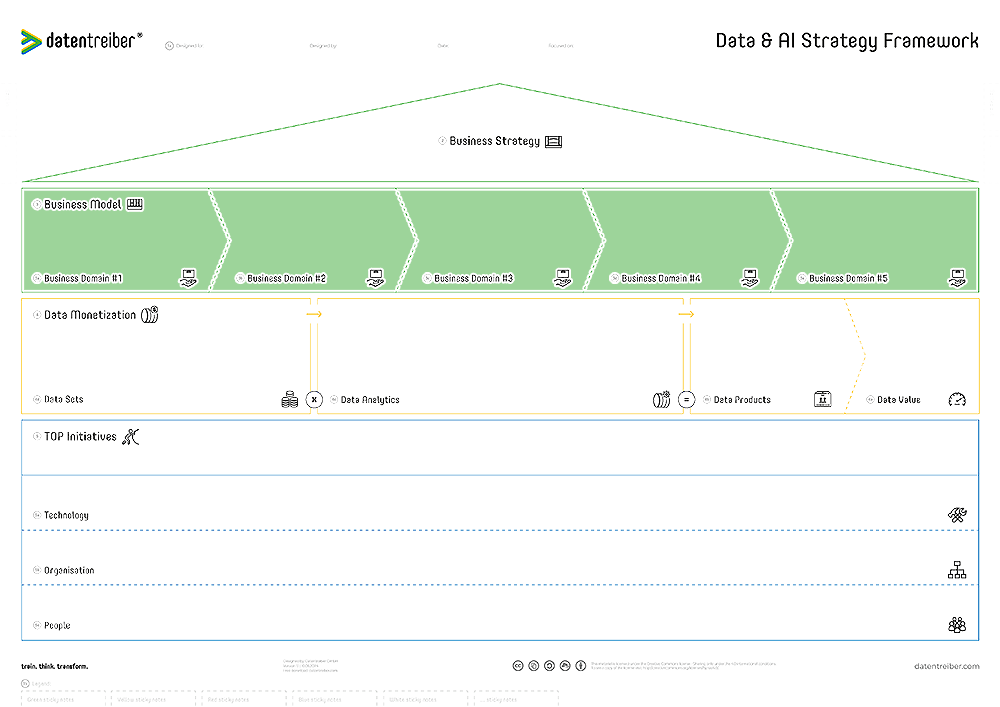
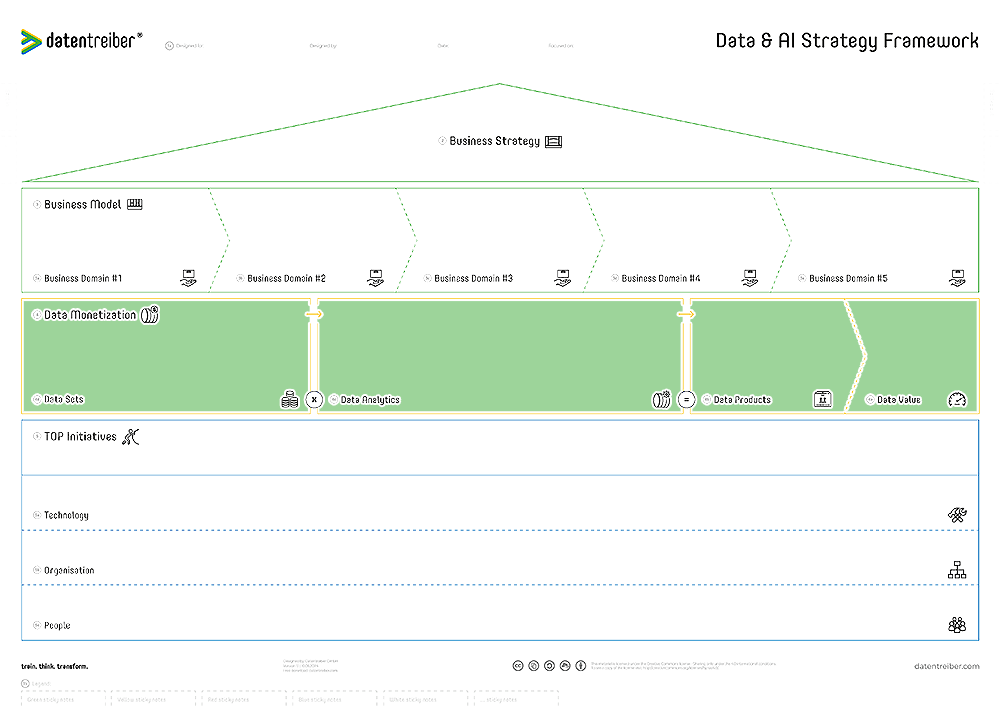
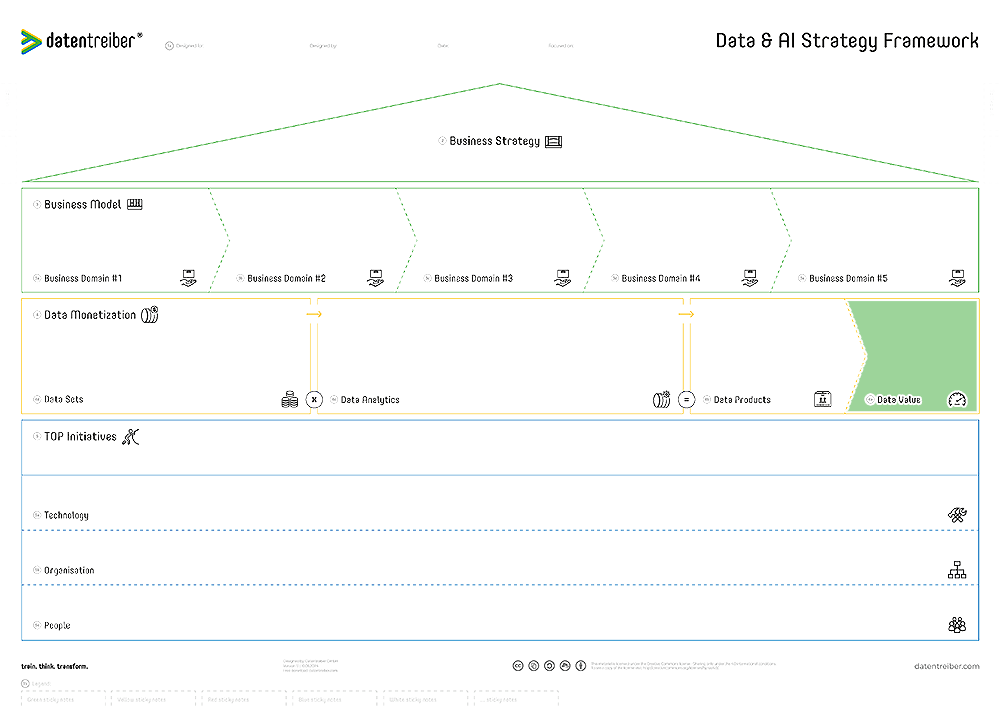

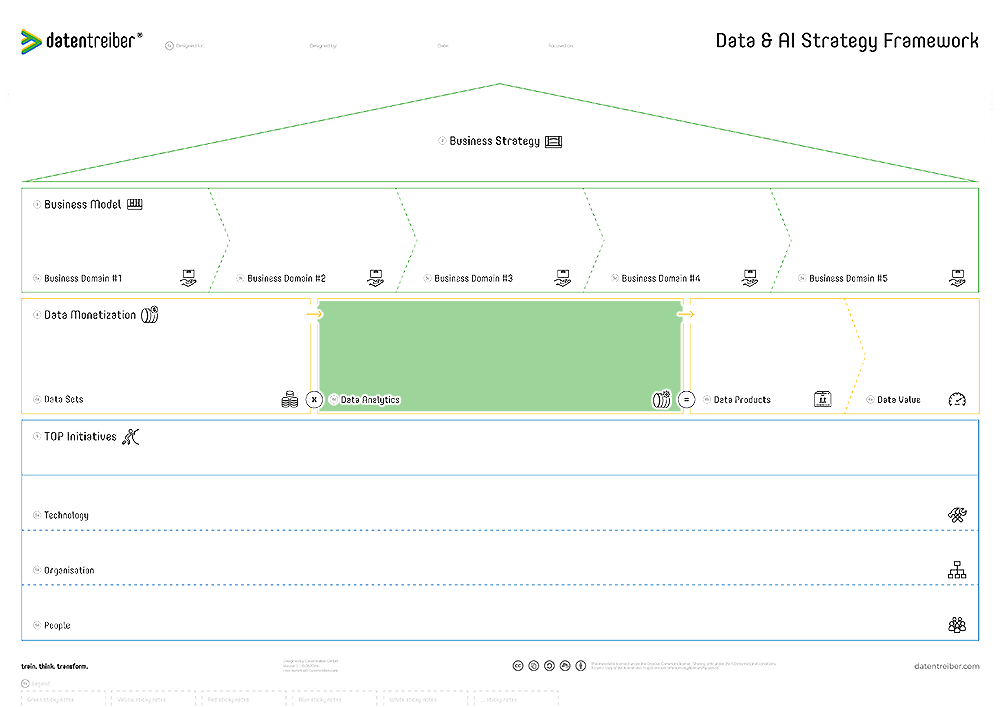
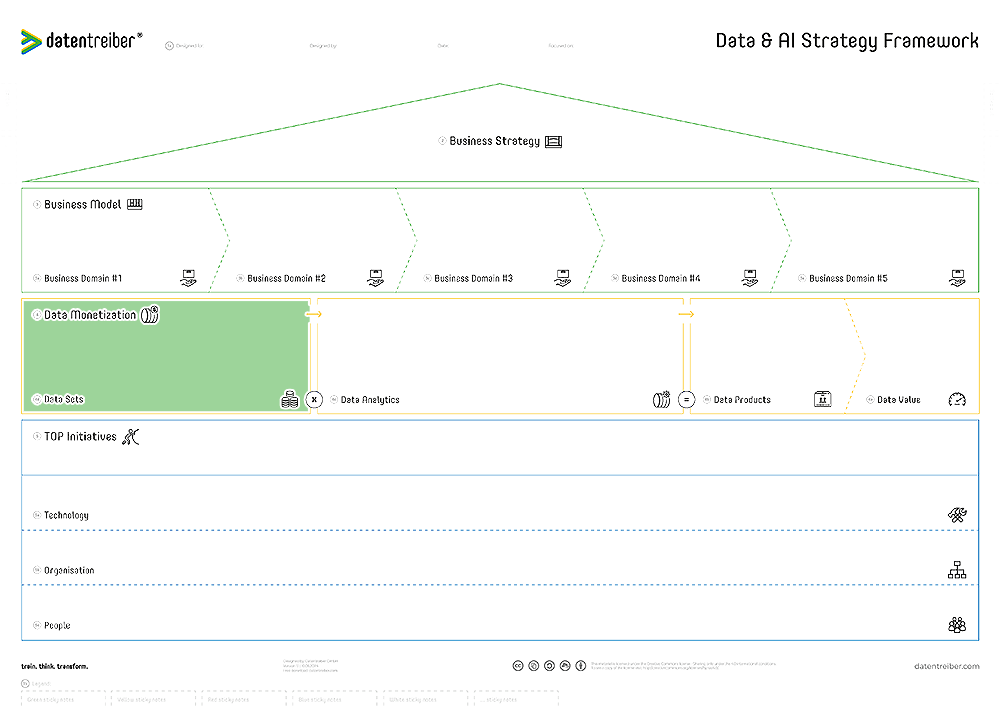
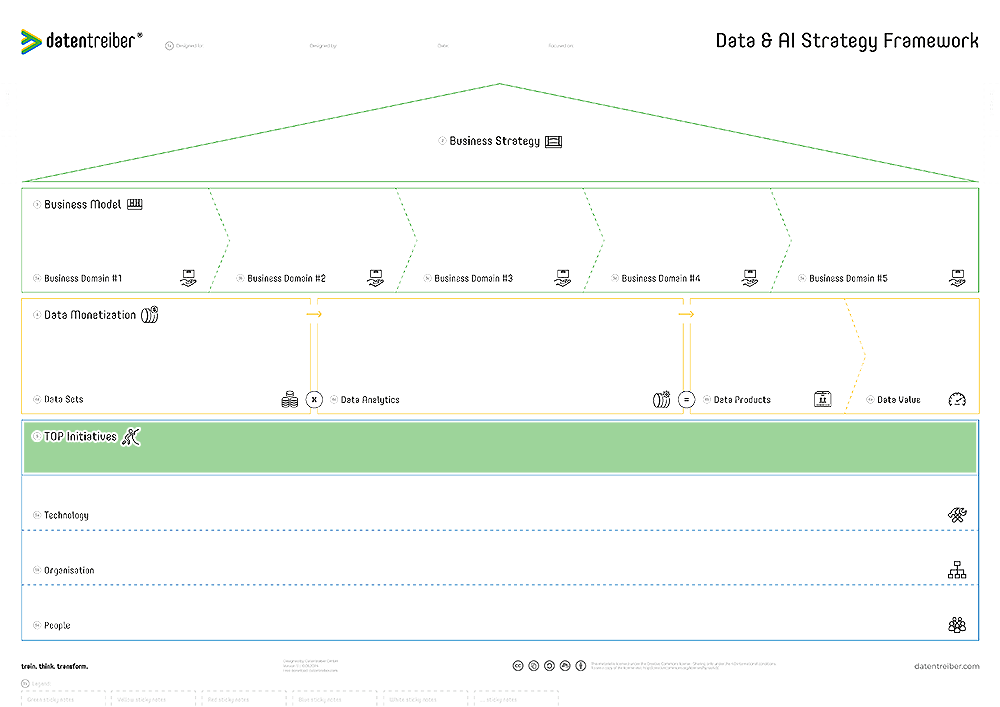
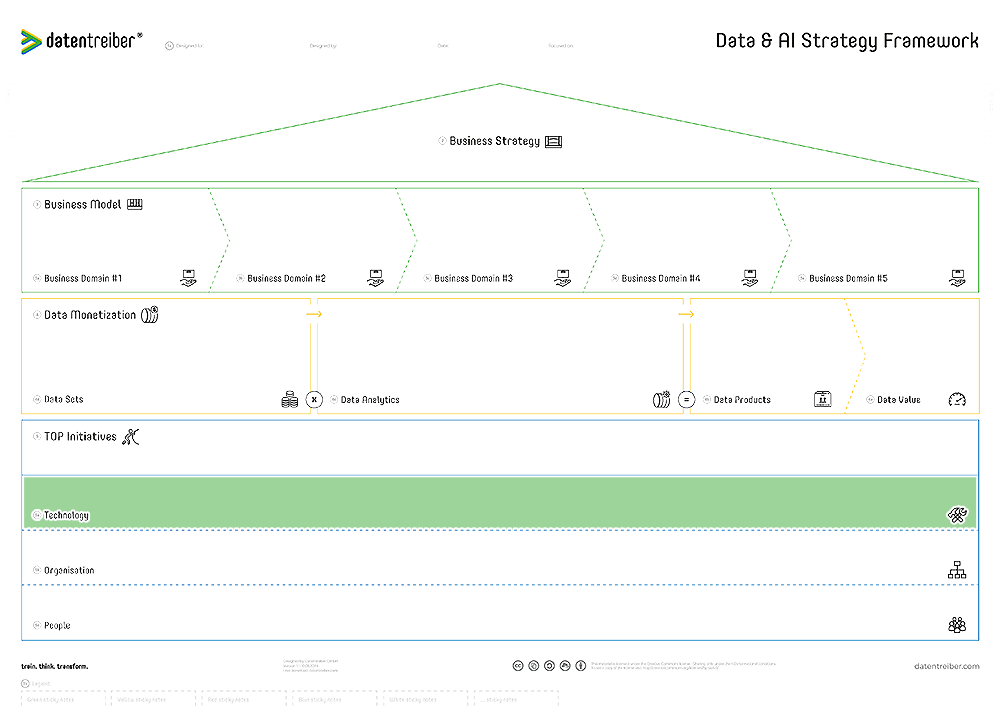
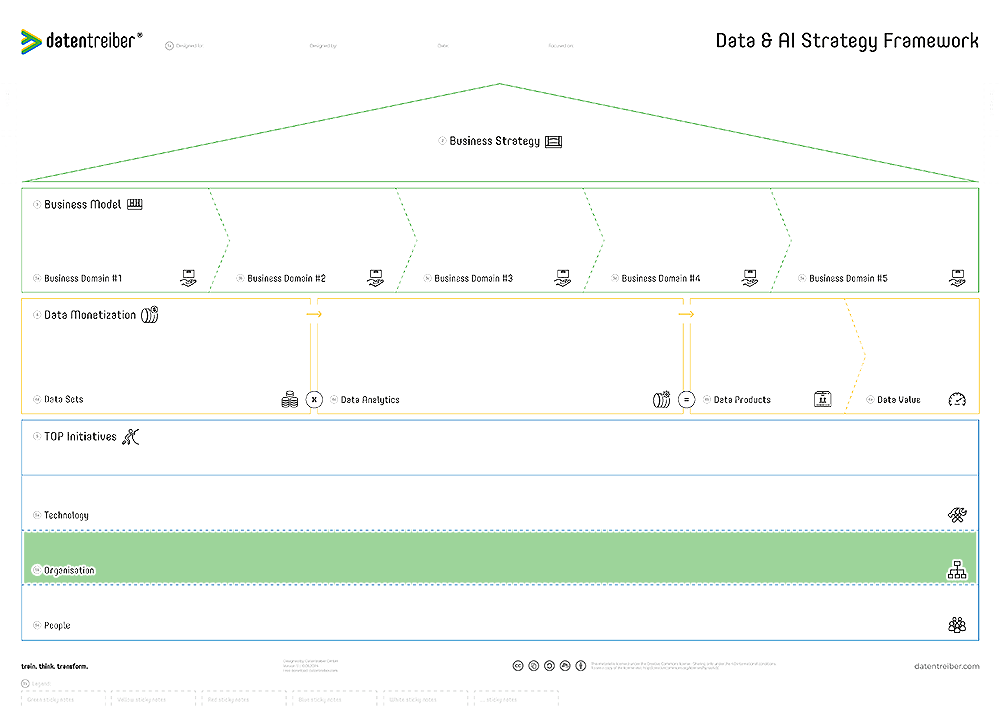
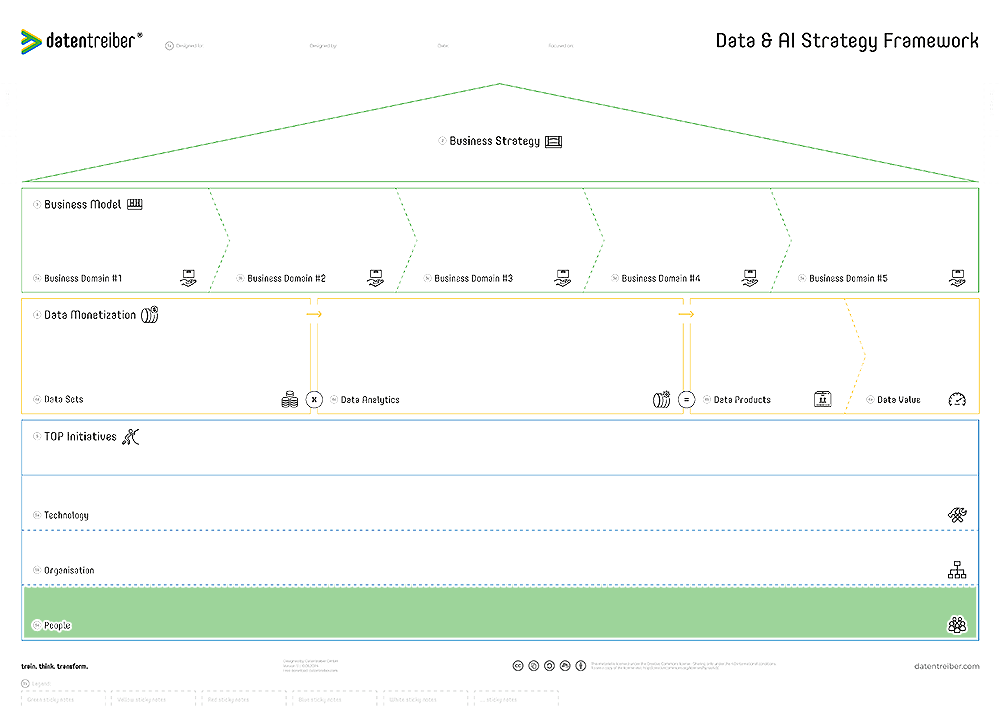
The Canvas Sections
1a Header
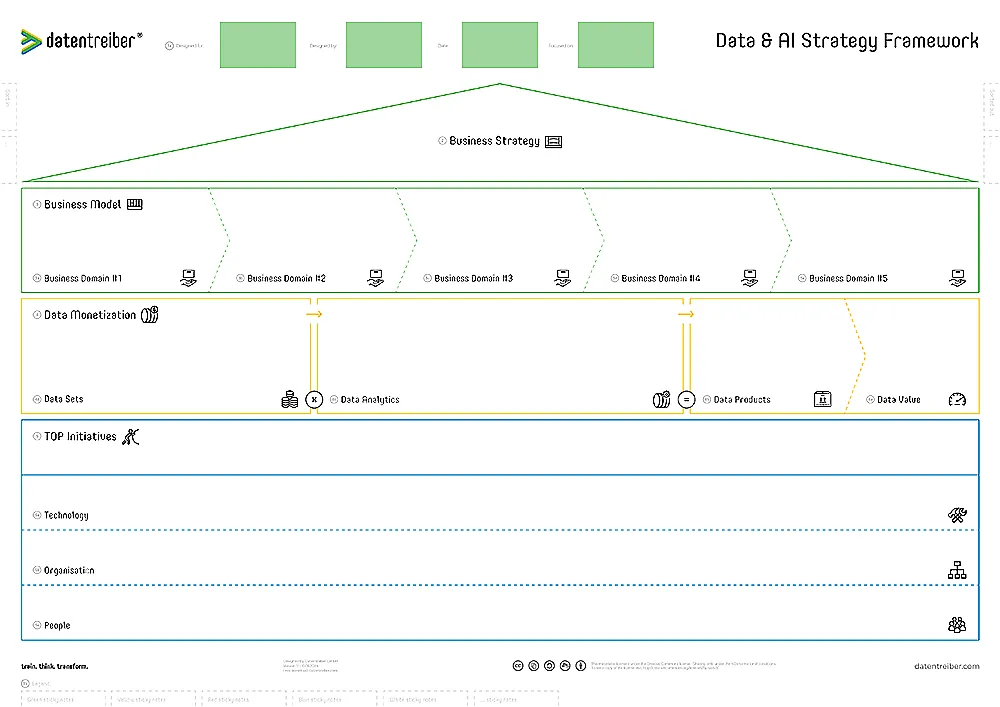
The header defines the content of the canvas and should consist of the following information:
- Designed for: Which organization (company, department, team, etc.) does the content of the canvas concern?
- Designed by: Which organization (company, department, team, etc.) created the content?
- Date: When was the content created or last updated?
- Focused on: On which area/topic/case/etc. does the content of this canvas focus?
There should be no copies of the same canvas with identical headers, i.e., the header clearly identifies a version of the canvas (copy) and documents the current status of its content.
2 Business Strategy
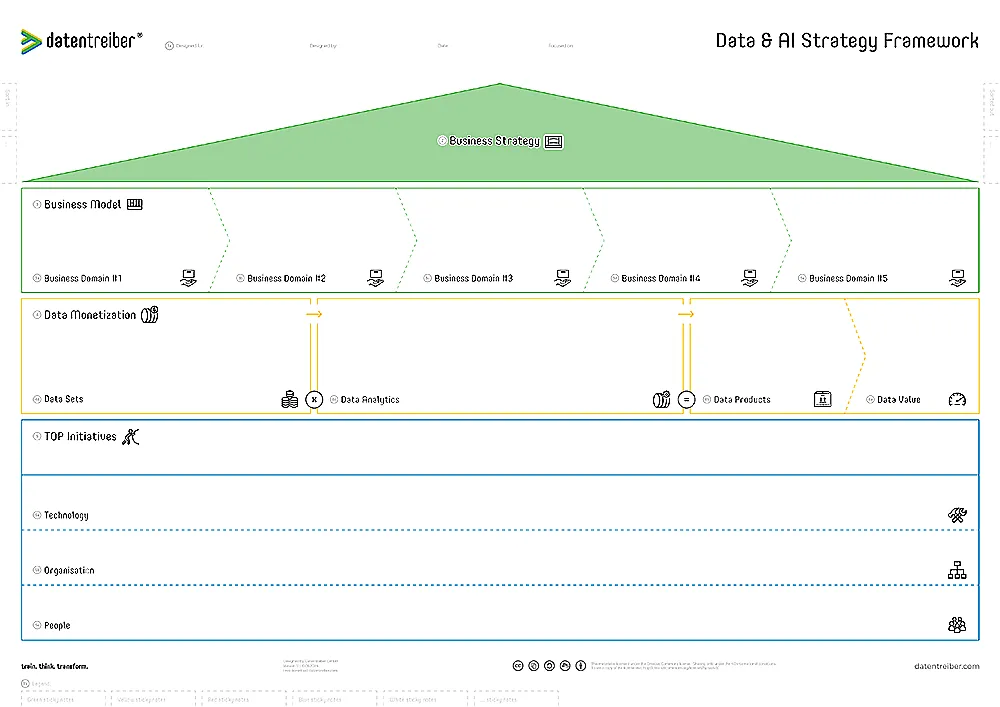
A business strategy answers (at least) three core questions:
- Why does the company exist (i.e., what is its purpose or value)?
The vision describes a positive future change for its customers and the company. - How does the company “play to win” (e.g., win customers against its competitors)?
The mission explains how the company intends to realize the vision through strategic initiatives. - What does the company need to achieve (e.g., product, process, or service innovations)?
The milestones set timed and incremental objectives along the mission (strategic business initiatives).
3 Business Model
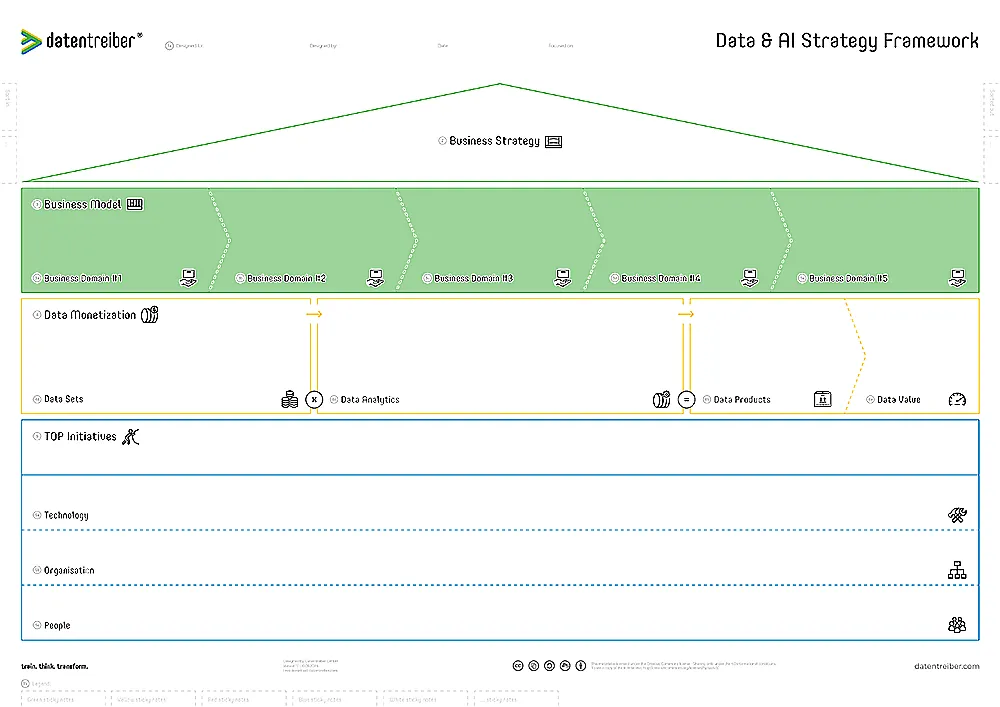
How does the company operationalize its business strategy?
The business model represents a value chain where the primary activities of the company are interconnected to create value (benefits) for customers and the company (revenues and advantages). A company might operate different business models (e.g., B2C and B2B). The structure of the business model depends on the respective business strategy (“Structure follows strategy”) and defines the critical business domains.
a-e) Business Domain
Which business domains are responsible for:
- Implementing the (strategic) business initiatives?
- Performing the (operational) business activities?
A business domain is responsible for related business activities aimed at a given objective and manages its respective business processes to deliver key results. The objectives and key results should align with the strategic business initiatives.
Results are the output of decisions and actions (the business process) by the business stakeholders, i.e., action takers and decision makers for this process. These stakeholders are potential users of data and AI to drive decisions, processes, products, and the business model.
Each business domain has a relevant set of data and AI use(r) cases. A use case is where a user applies analytics and AI to data to achieve a business objective or create a key result. It is defined by a problem, a user-centric solution, and a benefit for the user.
The domain-specific use cases define the desired data and AI products (also known as data-driven and analytical solutions). A data or AI product can cover several use cases and can be integrated into existing operational business applications or be provided via various analytical business applications.
A business domain could stretch over multiple organizational units, ensuring that relevant activities and processes are effectively managed and aligned with the overall business strategy.
4 Data Monetization
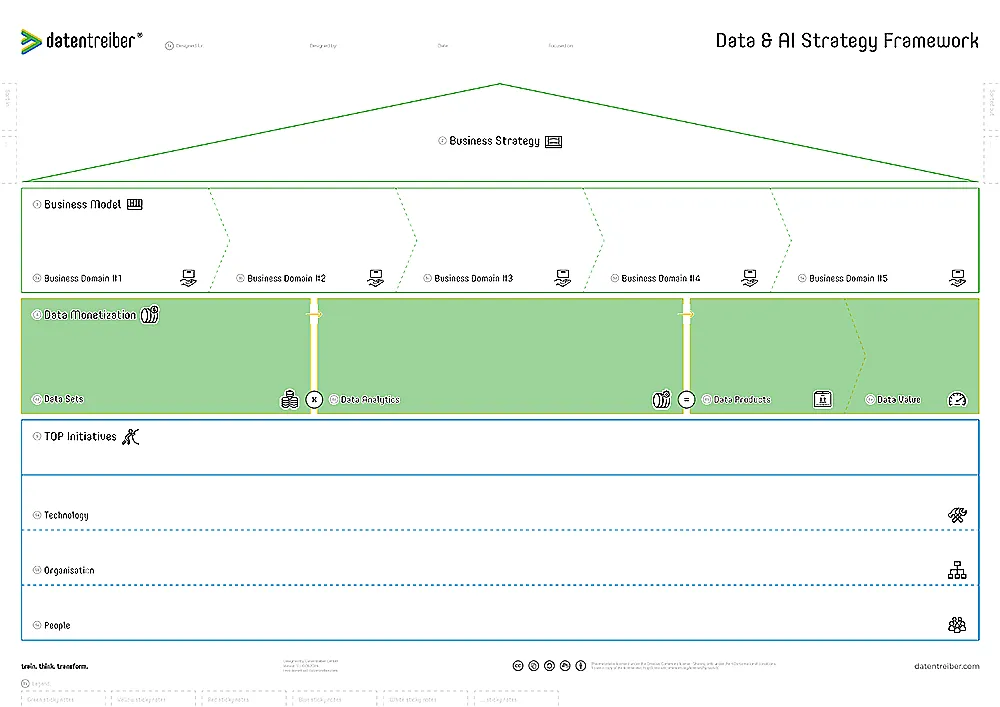
Why, how, and what data is utilized (through analytics/AI) to create (monetary) value for the business domains?
Data monetization can occur in two ways:
- Internally: Utilizing information from the data to increase revenue, decrease costs, and minimize risks.
- Externally: Licensing the data, data products, or information to customers.
4a Data Value
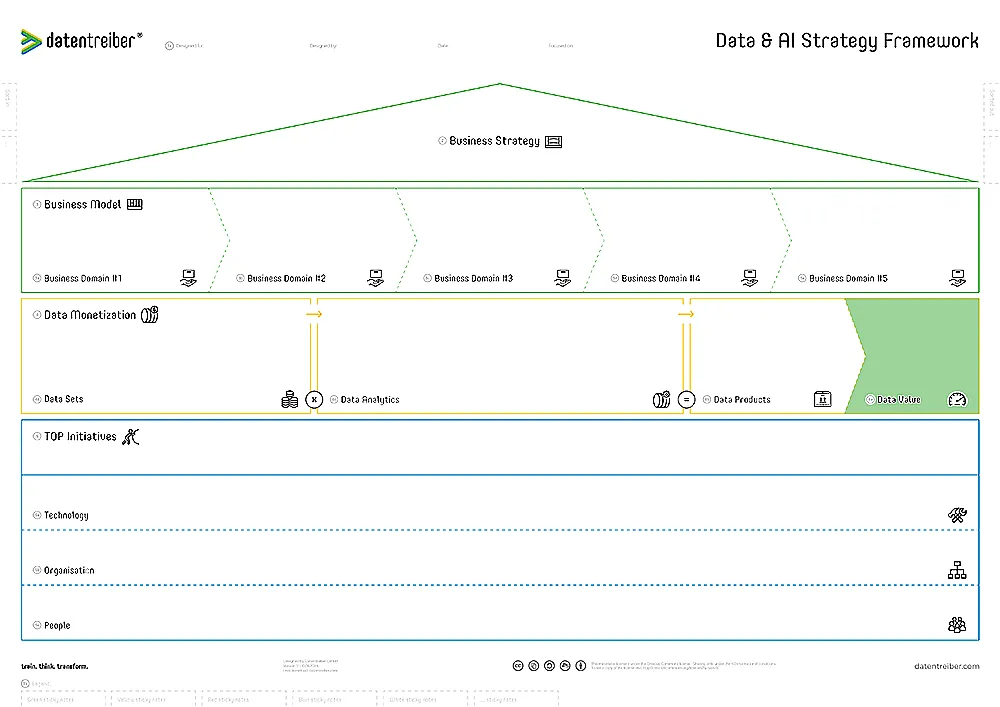
What is the value of the data for the business (strategy/model/domains)?
Data has (information) value if it helps drive business decisions, actions, results, and objectives according to the data value chain:
Data → Analytics → Information → Decisions → Actions → Results → Objectives
4b Data Products
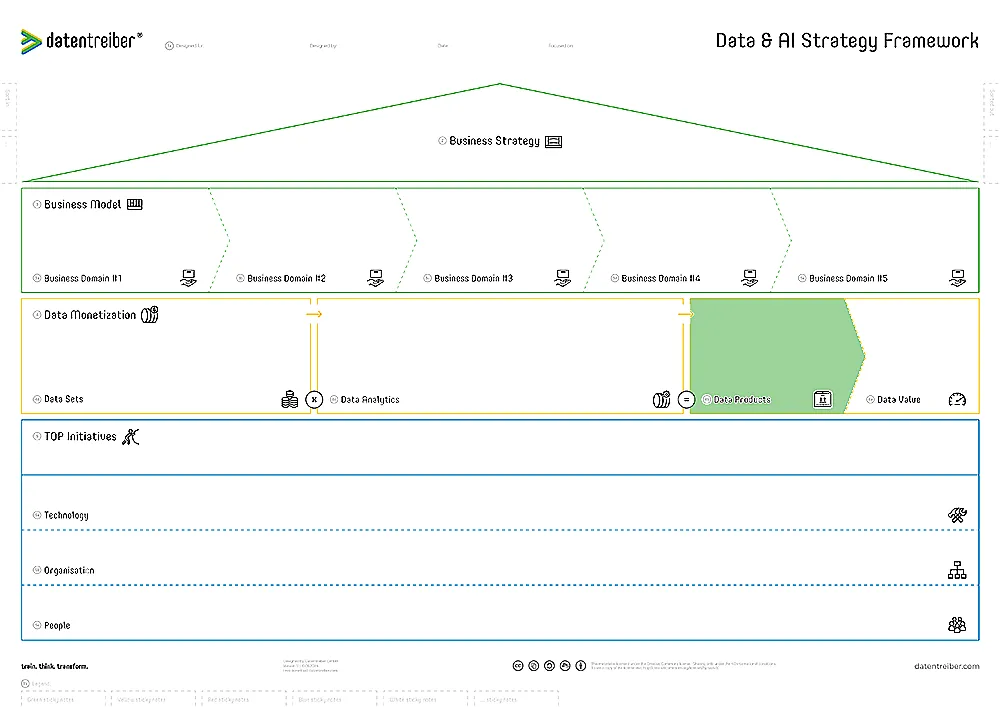
What are the data and AI products desired by the business domains?
A data product is the result of analytics applied to data to extract information. If done once and manually, it is an ad-hoc analysis (AHA). Data products, on the other hand, are reusable, scalable, software-automated analytical solutions that are part of a user-friendly application for various business users, covering several use cases.
An AI product is the result of machine learning models trained with data.
4c Data Analytics
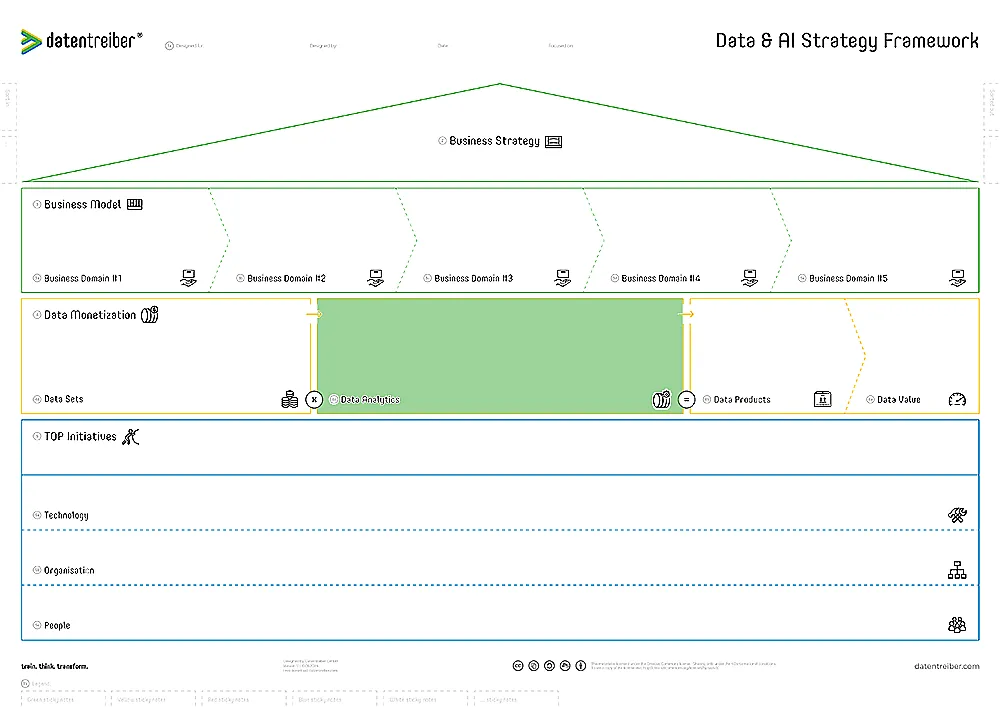
What are the required data analytics capabilities to obtain the desired information?
Data analytics refers to the computational analysis of data using techniques such as computational statistics or machine learning. The process of data analysis—also known as data mining—requires many processing steps:
Data sourcing → cleansing → transformation → integration → modeling → visualization → utilization
Data analytics is categorized by the analytics domain (e.g., marketing analytics, supply chain analytics), which is linked to a business application domain, and by its maturity:
- Descriptive
- Diagnostic
- Predictive
- Prescriptive
- Autonomous Analytics
Higher maturity comes with higher complexity and value, as the data value chain is covered further to the right.
Depending on the analytics maturity, the applied mathematical, statistical, or probabilistic technique, and the analytics domain, specific data analysis pipelines need to be implemented to provide capabilities such as generative AI:
Web scraping → word embedding → large-language model training → model evaluation → model deployment
4d Data Sets
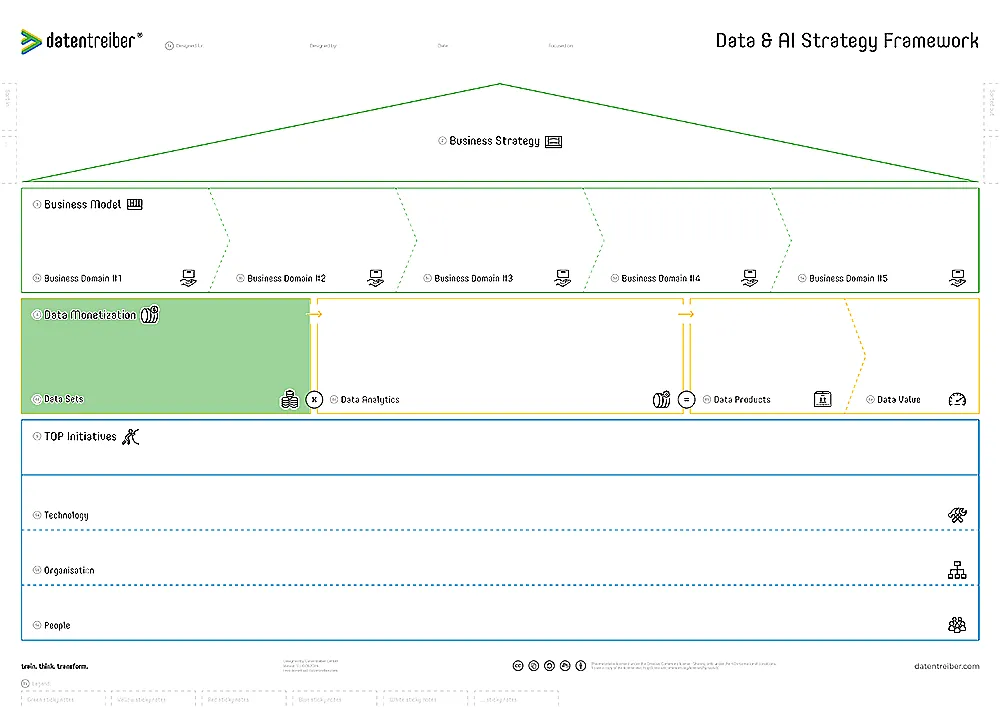
What are the data sets that serve as input for data analytics?
A data set is a collection of (related) data and originates from a data source, e.g. from an operational database (e.g., relational database system) or from an analytical database system (e.g., data warehouse, lake etc.). A data source can contain multiple data sets and its data can be structured (e.g., tabular data with records and rows), semi-structured (e.g., key-value pairs) or unstructured (e.g., text documents).
Data sources can be classified into raw or derived data and into owned, earned (0th & 1st party), paid (2nd & 3rd party) or public/open data. If data is monetized as a data product, it is a data asset. If the data set is needed but is not available, it is a data gap. If it is needed and available but there are problems with data quality, accessibility, privacy, security etc., it is a data issue.
5 TOP Initiatives

What are technological, organizational, and personnel (TOP) initiatives to build the necessary capabilities for a data-driven and AI-powered business?
An initiative is a series of prioritized, coherent, and consistent actions (including one-off projects, recurring measures, and ongoing activities) aimed at providing technical, organizational, and personnel resources and/or implementing necessary changes. The TOP initiatives create the required technical infrastructure, organizational structure, and personnel structure and culture for data monetization, with data and AI products sitting on “TOP” of this structural foundation. As “structure follows strategy,” these data and AI initiatives align with both the business strategy and the data and AI monetization strategy.
To implement and operate the technical infrastructure, an adequate organizational structure is required, which in turn needs the right personnel structure. The TOP structure is planned top-down but built bottom-up, iteratively and incrementally.
Typical TOP data and AI initiatives involve:
- Data and AI Management and Governance
- Data and AI Literacy and Culture
- Data and AI Architecture and Infrastructure
Additionally, a TOP initiative specifically for data and AI strategy and products is recommended, establishing the technical, organizational, and personnel requirements to advance the data and AI strategy and products.
5a Technology
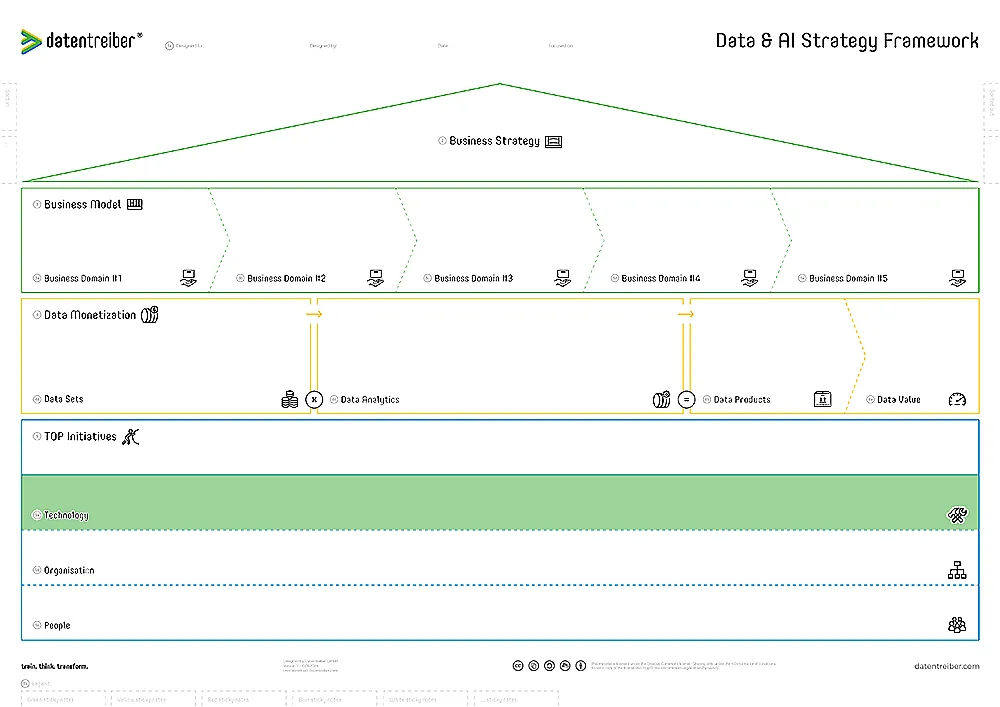
What are the necessary initiatives to create or change the technological infrastructure for the development and operation of current and future data and AI products?
Technological initiatives focus on:
- Technical Infrastructure: What hardware and software components are required to meet the needs of data and AI products?
- Technical Architecture: How do these components form a reliable, scalable, maintainable, adaptable, secure, and high-performing system?
The technical infrastructure and architecture are needed for:
- Development of Data and AI Products: Includes programming languages, frameworks, libraries, and tools for software development, data science, ETL, dashboarding, reporting, etc.
- Operation of Data and AI Products: Includes databases, cloud computing, feature stores, and tools for (meta) data management, DataOps, MLOps, ModelOps, etc.
To avoid the “fool with a tool” trap, tools and training should be provided together to ensure adequate skills.
Another common trap is “boys need toys,” where tools are acquired without intended use. The technical infrastructure should fit the data monetization requirements, avoiding unnecessary investment and recurring costs. It should not be undersized either, to avoid performance, security, legal, and maintenance issues.
Systems design and systems thinking are techniques for designing socio-technical systems. The aim of the TOP initiatives is to create one system – rather than several systems competing for financial, human or data resources.
5b Organization
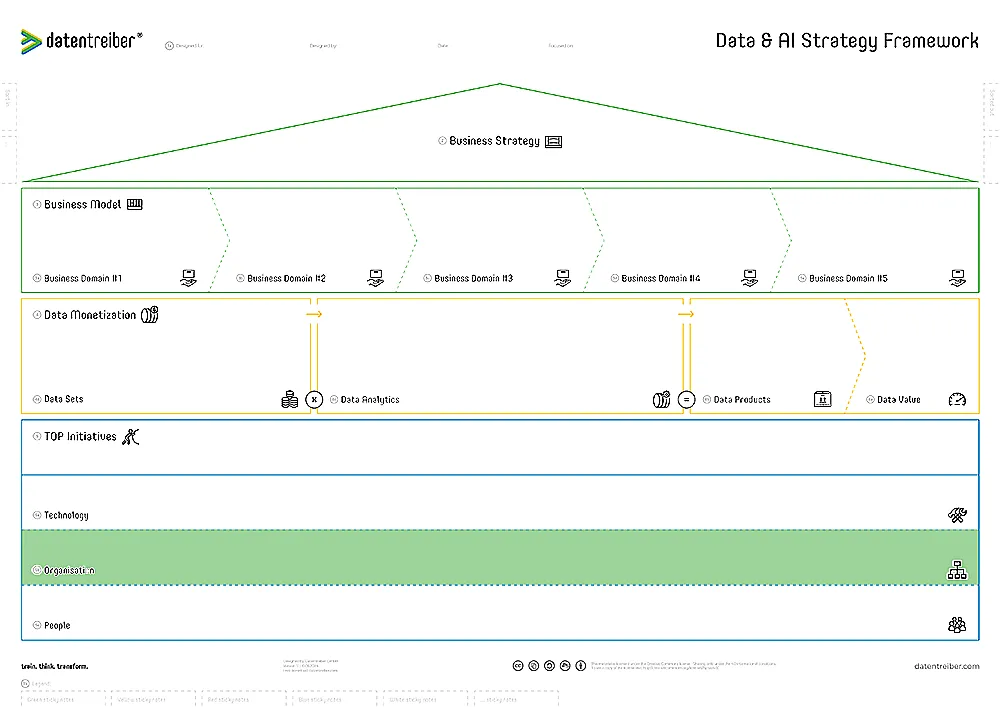
What are the necessary initiatives to change the organization or establish new organizational units that take responsibility for the development and operation of the technical infrastructure and the data and AI products?
An organization is a group of people joined together for a specific purpose, such as developing and operating a specific data and AI product. An organizational unit can be a legally independent entity, a division or department within the company, or a temporary, cross-departmental, or cross-company working group.
An organization is defined by its:
- Purpose: Why does the organization exist? Just as a company has a business strategy, a subordinate department also needs a strategy. For example, the Data and AI unit is responsible for the data and AI strategy.
- Roles: Who has what objectives (responsibility), must deliver what key results (expectations), can take what actions (skills), should make decisions about what (authority), is allowed to know what information (communication), and works with whom and how (collaboration)?
- Structure: What are the relationships (reporting, requirement, responsibility, etc.) between the roles and units? Examples include matrix, hierarchical, hub & spoke, holacracy, or (data) mesh organizations.
- Processes: How do the decisions and actions by different roles work together to create the expected results? For example, how are data errors identified, resolved, and avoided, or how are data and AI use case proposals evaluated, prioritized, and scheduled for implementation?
Conway’s Law states: “Organizations which design systems (in the broad sense used here) are constrained to produce designs which are copies of the communication structures of these organizations.”
Therefore, the organizational structure should reflect the system architecture, such as in a data warehouse or data lake system.
5c People
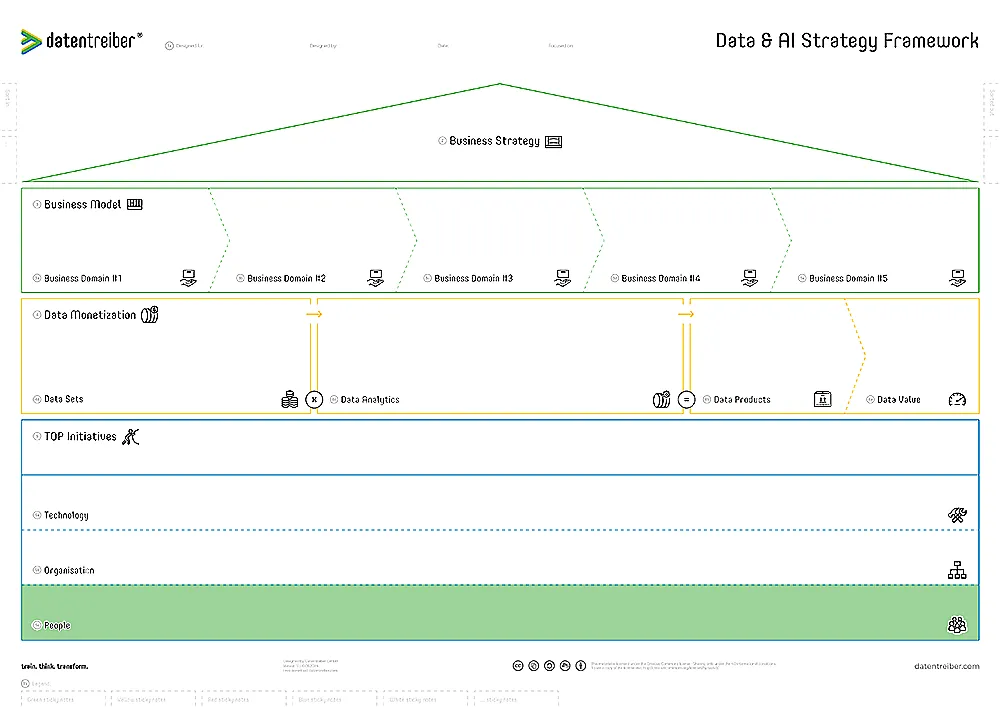
What people do we need to equip the organization with the necessary competencies and capacities?
People are the foundation of a business, especially a data-driven and AI-powered one. They bring the necessary qualifications and ambitions.
For an organization to function, it needs the right:
- Personnel Structure: What hard and soft skills, professional experiences, staff capacities, and availabilities does the company need or no longer need? Rethink your hiring strategy to look for T-shaped people who are profound specialists in one topic but also shallow generalists in other topics.
- Personnel Culture: What values, rules, beliefs, norms, principles, behaviors, rituals, leadership, and communication styles do people live and work by? For example, does the leadership team value autonomy over authority, an essential principle for data-driven organizations?
For people to work together efficiently and effectively, they need one mindset, which includes:
- Joint Purpose: It is important to have a unified, clear, and accepted business strategy. The quality of the strategy is less critical than its actual implementation, which requires all employees to work on its execution.
- Shared Knowledge: To avoid misunderstandings and enable efficient communication, people must share basic knowledge, especially about data and AI, known as data and AI literacy.
- Mutual Understanding: Data and AI products are complex innovation projects with a high failure likelihood, necessitating interdisciplinary teams to co-design, co-develop, and co-operate.
- Common Values: Conflicts, such as cultural or interest clashes, are inevitable. It is important to have common value-based rules to resolve such conflicts.
Data-driven and AI-powered business is people business.
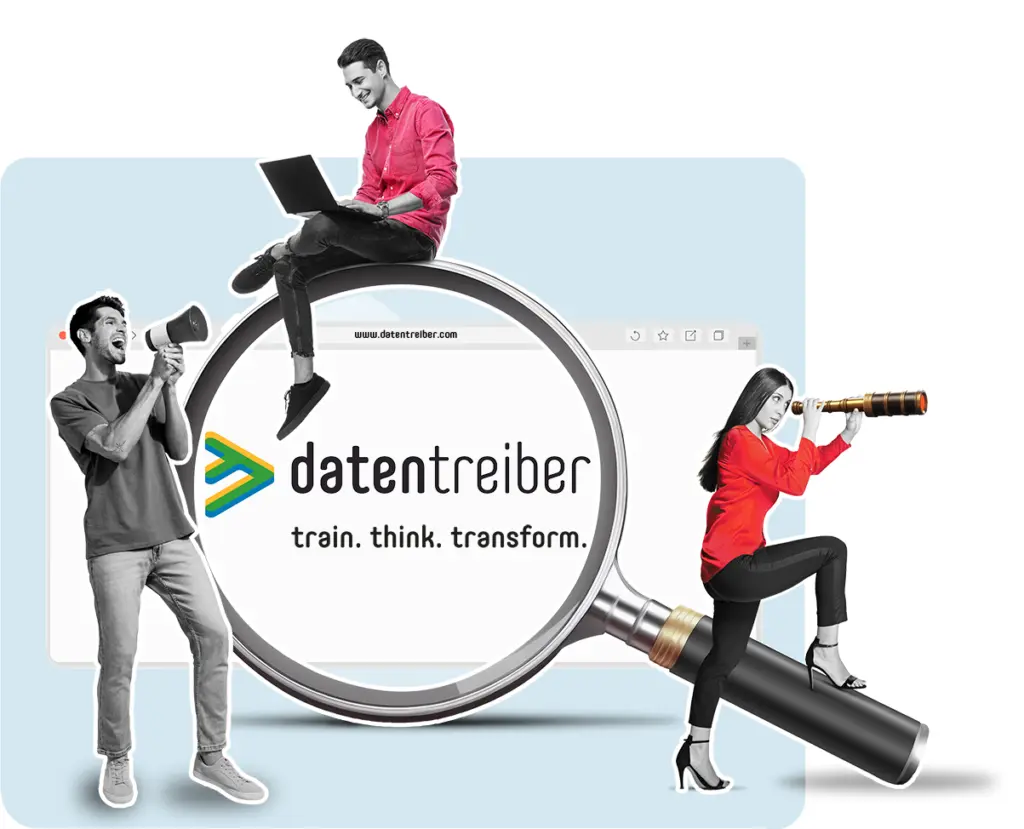
Where Can I Find More Information?
- Find detailed tutorials and examples on how to use the canvas in the context of designing a fully integrated data & AI strategy in our Data & AI Design Bench.
- Data Thinker Group (LinkedIn)

